Reading Time: 7 minutesIn this article, we’ve collected methods to recover files from a Fujifilm camera. The methods allow you to retrieve deleted photos and videos, regardless of whether the loss occurred on the camera itself, on your computer when you connected a memory card, or as a result of formatting. With these methods, you can get your deleted files back from Fujifilm regardless of your technical skills.
Is It Possible to Recover Photos from a Fujifilm Camera?
Yes, in most cases, you can recover lost files from a Fujifilm camera. Because these cameras don’t have built-in memory, recovery focuses on the SD card they use. Several factors will affect your chances of success.
- ⏳ The first factor is how much time has passed since the deletion. If you catch the mistake right away, your chances of recovery are much better because the files still exist on the card, but their space just appears free for new data. But if you kept taking photos or videos after deleting, you probably overwrote those files. After overwriting, recovery isn’t possible. Also, some SD cards, especially those based on the newer UHS-II and UHS-III standards, include automatic garbage collection features like Wear Leveling and TRIM. These processes improve performance and durability but can also permanently erase deleted files by clearing the space marked as free, making recovery impossible after garbage collection runs.
- 🚩 The next important factor is the state of the file system for file access. If your camera or PC can read SD card, that’s a good sign. If not, it may be corrupted. In this case, you can try creating a byte-to-byte copy of the SD card from your Fujifilm camera and recover files from that copy. Or, you might want to take it straight to a professional data recovery center.
- 🔨 Physical damage to your SD card, like scratches or water exposure, changes everything. If your card is physically damaged, stop reading this article and head straight to a professional data recovery center. Avoid DIY fixes. A damaged card is fragile, and any more handling could ruin it completely and cause permanent data loss. Trusting the pros is the safest move.
Also, lock the card to prevent accidental writing. Most standard SD cards have a physical write-protect switch on the side. Sliding it to the locked position stops new data from being written, which boosts your chances of a successful recovery. This feature is on most full-size SD cards and microSD cards with adapters.
How to Recover Deleted Files from a Fujifilm Camera
Actually, there aren’t many ways to recover deleted files from Fujifilm cameras – either restore from backups (if you have them), use photo recovery software, or turn to professional services. The disadvantage of the backup method is that it should have been created before the data loss. And honestly, if you had backups, you probably wouldn’t be reading this article. So, we’ll concentrate on two other methods below and begin with data recovery software.
Method 1: Use Data Recovery Software
The only real option you have to recover deleted files from a Fujifilm camera on your own is to use data recovery software. These tools scan your SD card’s file system, look for traces of deleted files, and try to bring them back. This only works if those files haven’t been overwritten yet. To get the best results, you’ll need software that’s good at handling fragmented files.
Fragmented files happen when a file’s data gets split up and stored in different spots on the storage device. To recover them, you need advanced software that can correctly piece everything back together. Basic recovery tools usually can’t handle this well – they might miss parts or bring back corrupted files.
We recommend Disk Drill. It offers a high recovery rate and an intuitive interface. Its latest version, Disk Drill 6, features an Advanced Camera Recovery module designed specifically for fragmented files from cameras, including Fujifilm. It can restore videos (MP4, MOV), photos (RAF, Fujifilm’s unique RAW format, and JPG), and even audio files (WAV). This means none of your deleted files should be lost.
If you think your Fujifilm SD card might be corrupted and want to try recovering the files yourself, create a byte-by-byte image of the card. This protects the original data in case anything goes wrong during recovery. You can follow the steps to make that image here.
- Download Disk Drill from the official website and install it on your computer. Once installed, open Disk Drill and insert the SD card from your Fujifilm camera into your PC.
- In the left sidebar, click on the Advanced Camera Recovery section.
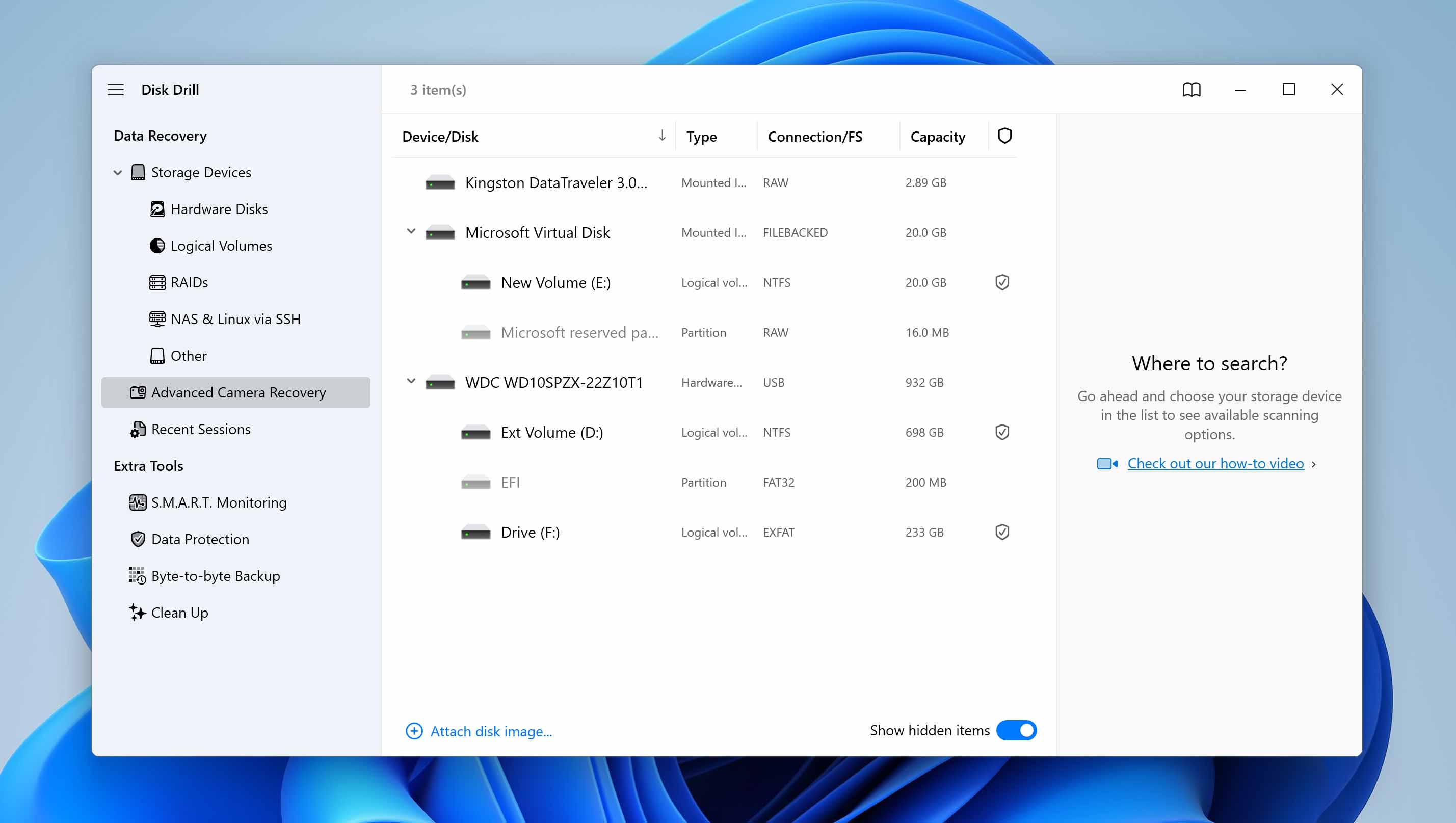
- Select your SD card from the Device/Disk list. If you created an SD card image earlier, click Attach disk image at the bottom and select the image from the list.
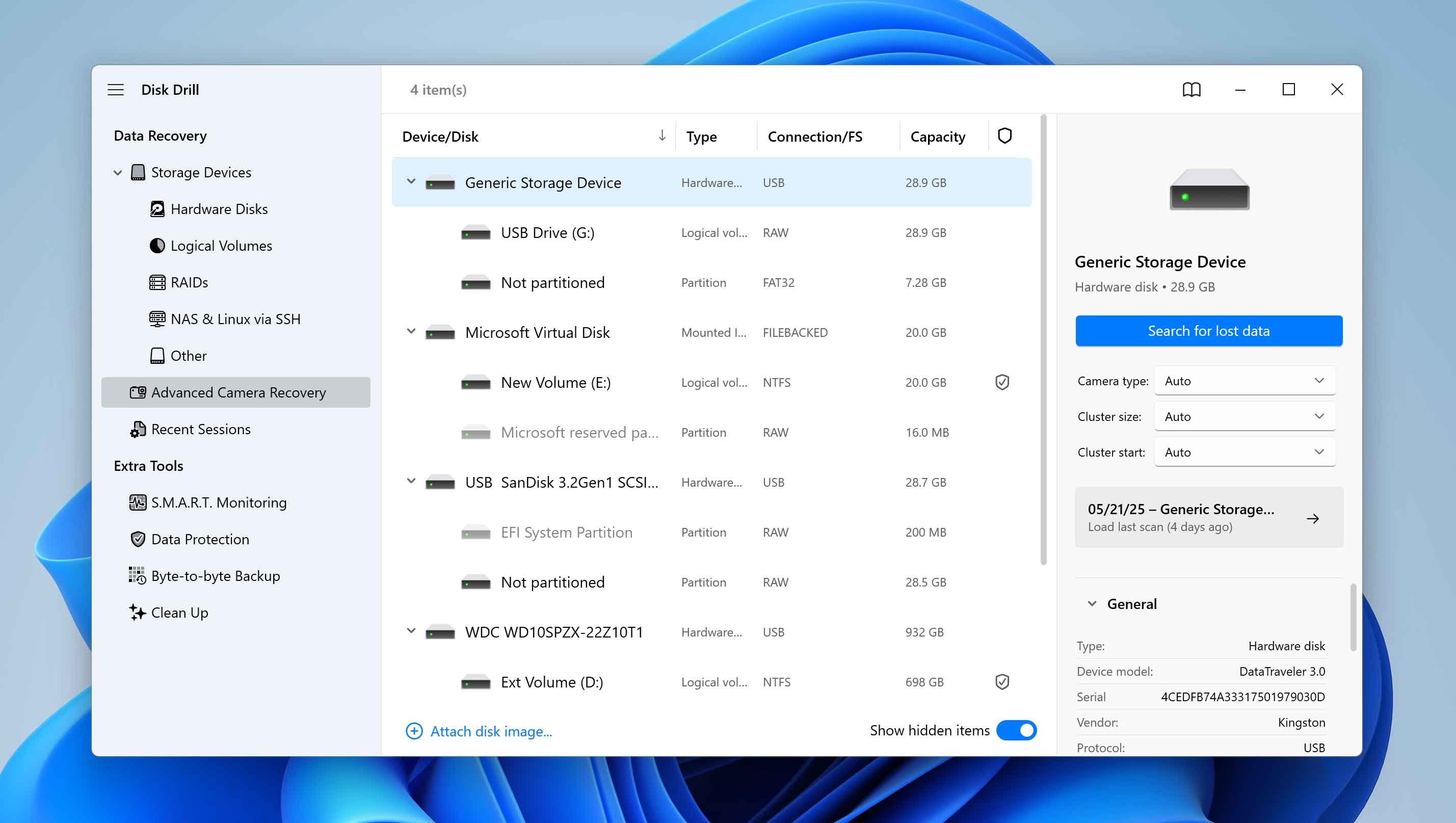
- On the right, under your device’s image, click the Camera type and choose Fujifilm from the drop-down menu.
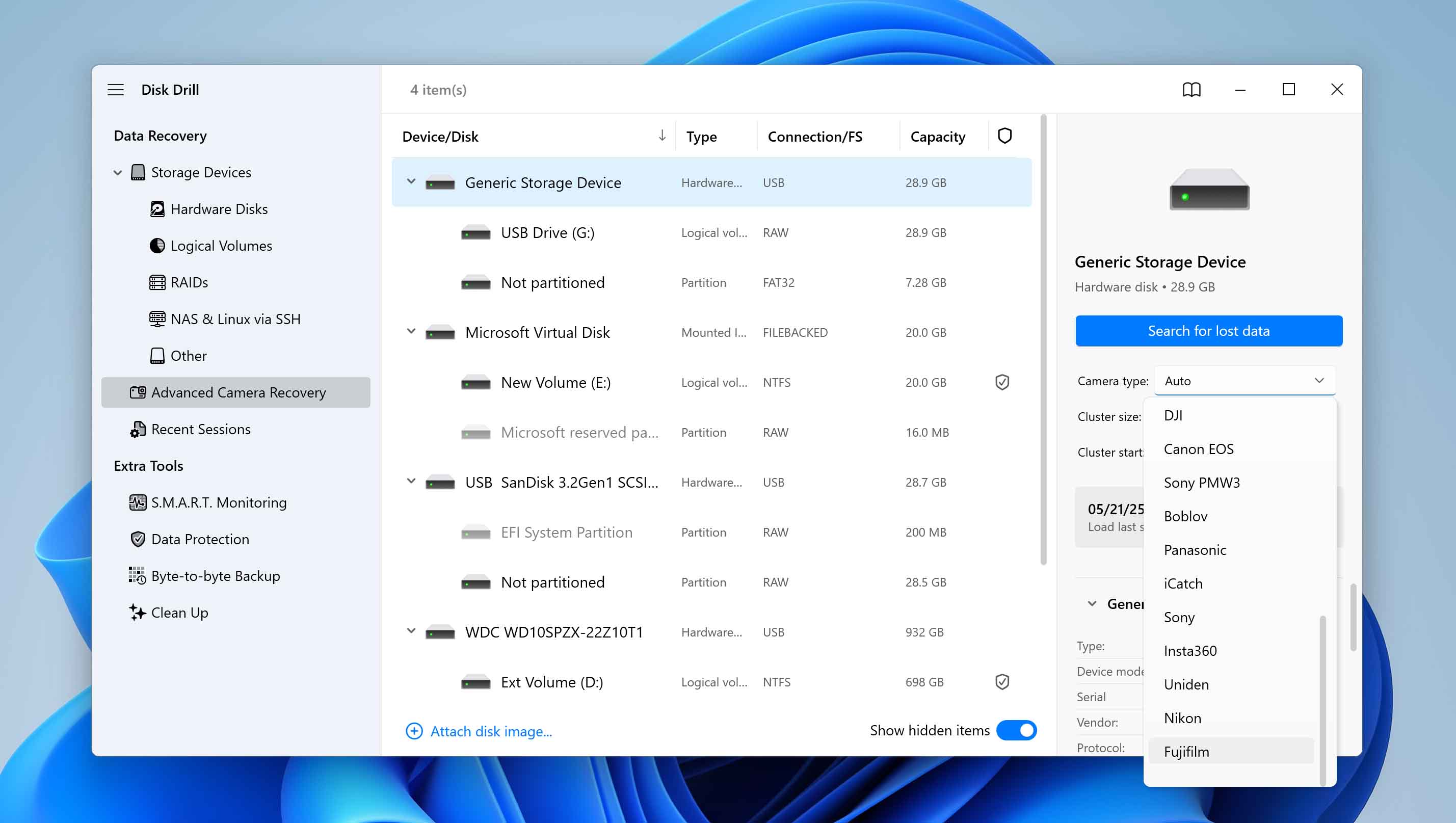
- Click Search for lost data to start scanning.
- Track the recovery progress at the top of the window. When the scan finishes, click Review found items to view the recovered files.
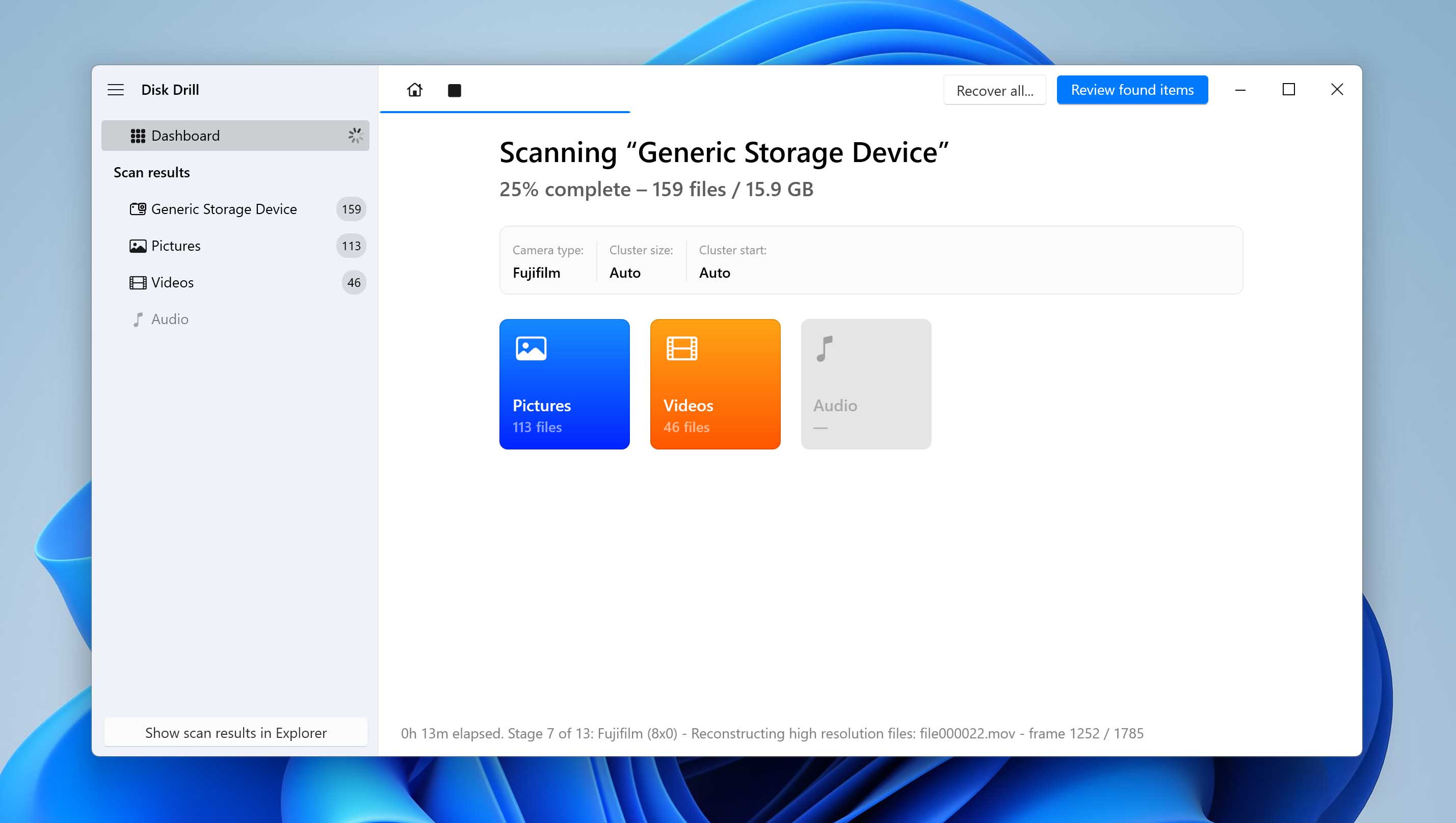
- You’ll see three categories on the left: Pictures, Videos, and Audio. Select the category you need.
- Browse through the results, and click files to preview them if the names aren’t clear. Select the files you want to recover, then click Recover to start the process.
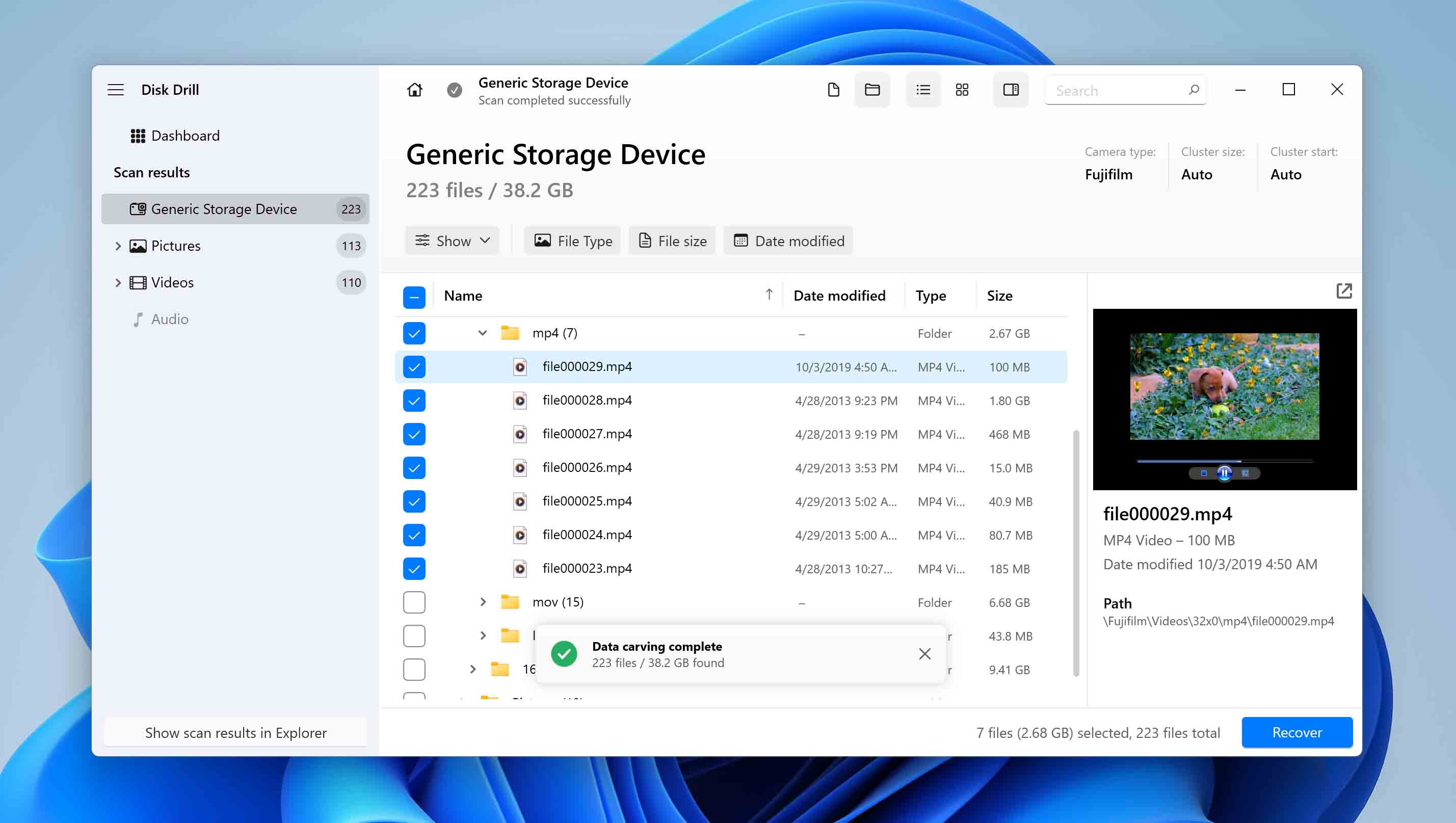
- Choose a destination folder for the recovered files, make sure it’s different from the SD card to avoid overwriting data. Click Next.
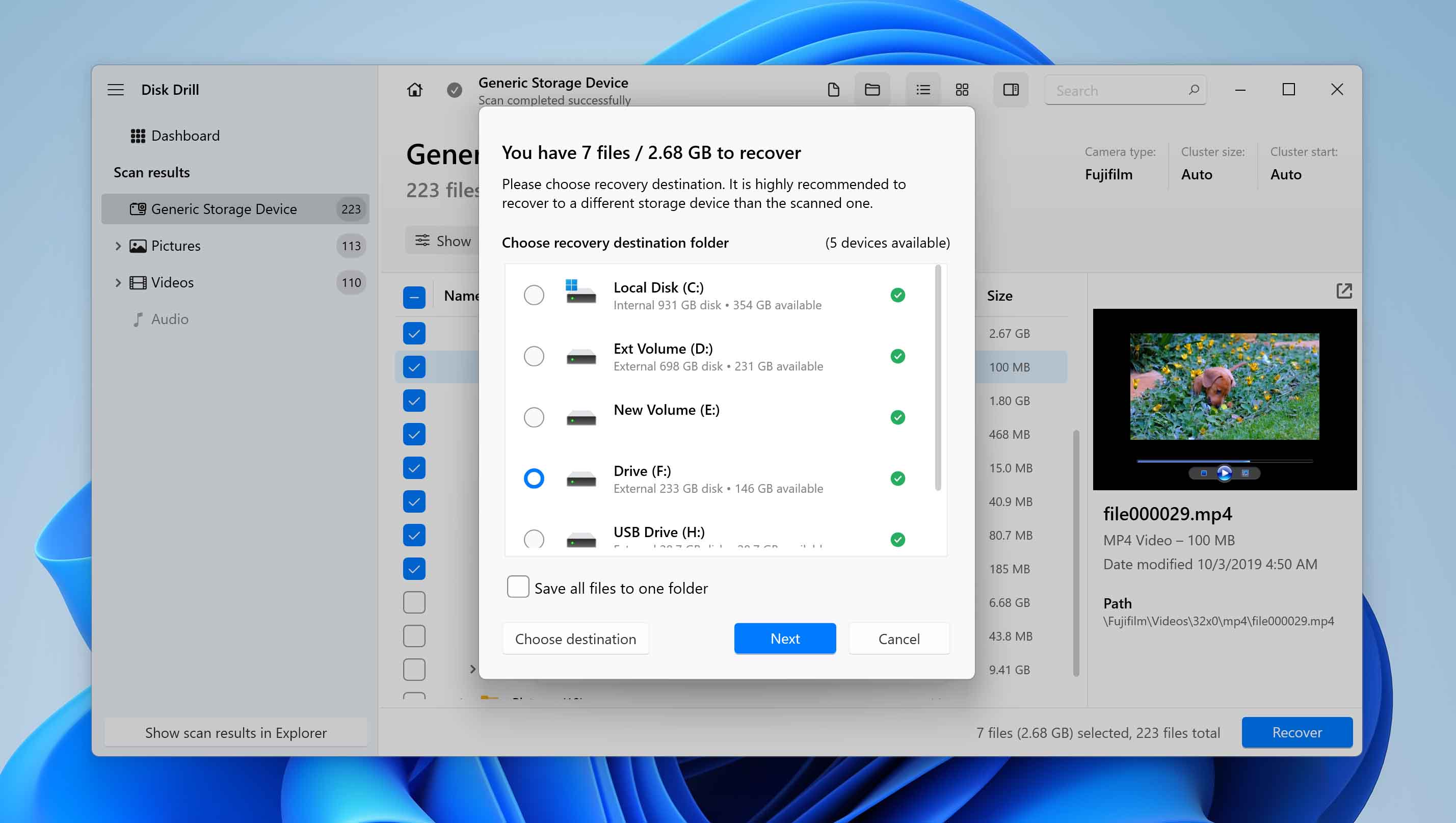
- Once recovery finishes, click Show recovered data in Explorer to check your files, or close the program if you’re done.
Disk Drill offers a free trial for Windows users that lets you recover up to 500 MB of data for free. That’s enough for a few photos or a short video. If you deleted all the files on your Fujifilm SD card, you’ll need to upgrade to the Pro version to recover everything.
Method 2: Send Your SD Card to a Data Recovery Service
In most cases, where you only need to recover a few files and your SD card is not physically damaged, you can use Disk Drill to recover deleted data without paying.
But if your SD card is physically damaged or your files have been severely corrupted, data recovery software might not be able to access and retrieve these files for you. In that case, a professional data recovery service is your best chance to retrieve the deleted data because they have all the necessary tools, specialists, and knowledge for data recovery.
If you decide to contact a data recovery service to recover deleted files from a Fujifilm camera, follow this approximate sequence of actions:
- Pick a trustworthy data recovery service. Check online reviews and concentrate on feedback from cases like yours.
- Reach out to the service via their website, app (if they have one), or phone. Explain your situation, set up a work order, and schedule an evaluation.
- Send or drop off your SD card. Pack it carefully to avoid any damage during shipping.
- Once the service receives your card, it will inspect it, give you a cost estimate, and contact you. The inspection is usually free.
- After you approve the quote, they’ll start the recovery process. They’ll recover what they can and return your files – either through cloud storage or on a new SD card if that option is available.
- When you get your files back, make sure to handle your SD card carefully to avoid the same data loss issues in the future.
Wrap Up
No matter how files get deleted from your Fujifilm camera, you can recover them as long as the data still exists on the SD card – until the files get overwritten or erased by the card’s special functions. If your SD card is working fine, feel free to use Disk Drill or similar tools, though there aren’t many options, since only a few photo recovery programs can handle fragmented files well. If you suspect the SD card is corrupted, you can try data recovery software or contact professionals. But if the SD card has physical damage, don’t hesitate and go straight to a data recovery center.
Careful handling often prevents the need for recovery. Going forward, think twice before deleting files. If your SD card has enough space, keep extra files until you have time to review them instead of deleting and then hunting for ways to restore them.
Treat your SD card gently to extend its life. Always eject it safely from your Fujifilm camera and computer. Avoid interrupting file transfers. Keep the card clean and dry, and store it in a protective case when not in use. And don’t forget to regularly back up your photos after transferring them to other devices.










